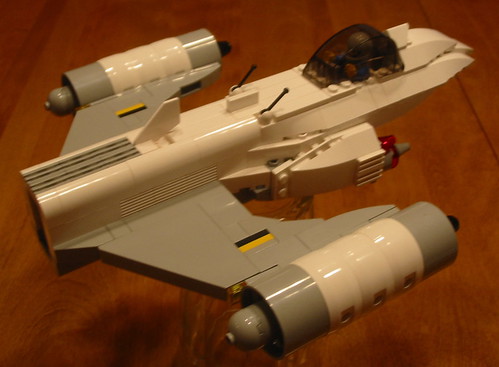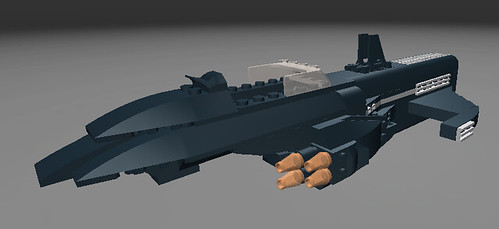Saturday, May 13, 2006
Looks Like A Fish, Moves Like A Fish, Steers Like a Cow: My Long Tail Adventure
by Tom Bozzo
As I'd mentioned earlier in the week, the very cool LEGO Factory concept — design your own LEGO set on the computer, transmit the CAD file to shop.lego.com, and get the real parts to build it — took a huge leap towards very cool reality with the introduction of the first incarnation that actually provides fully customized parts assortments.*
Clearly, this involves some work on the part of the customer-designer. So how does it work? The short answer is pretty well. A fuller report with some pictures is after the jump.
After an 18 MB download, I installed the Lego Digital Designer (LDD) software without difficulty on my iMac G5. LDD has a totally nonstandard interface that's undoubtedly aimed at children; since the Mac download package omits the instructions, I had some difficulty navigating the controls at first. Based on the usually quiet iMac's fan noise, LDD sounds like a CPU hog.
The current part assortment includes 254 brick types, not counting color variations. While only a small fraction of the full variety of LEGO bricks, it's a workable start. Color availability can be limiting even for some varieties of basic brick, though. Looking over the available pieces, my best bet for a creation based on something I'd already more-or-less thought out was this:

However, many of the white and gray pieces aren't available currently, nor are the canopy and the parts used for the large engines on the wingtips. A workable assortment was available in black. The only windshield available would make for an open-roofed air-speeder if the model was somehow to accommodate a minifigure.
In black, the speeder could be a hearse, a limousine, or a sinister-looking hot rod. I went for a combination of all three:

I got what I like to think of as an air-speeder suitable for the fictional rock star Hotblack Desiato — Douglas Adams fans might recall that in The Restaurant at the End of the Universe, Desiato was spending a year dead for tax reasons.

The model's special hidden feature is a slot where the Han Solo in carbonite brick can be inserted. Despite its Star Wars origin, it's as suitable a representation of a temporarily deceased rock star as anything.
As for the time commitment, the speeder contains 250 pieces and took a couple hours to build. It was occasionally slowed down by pieces that didn't want to slide into place. The model uses an elementary form of what's called "SNOT"** in the LEGO community — the fuselage is built with upper and lower halves — and LDD sometimes resisted brick placements where the halves meet. If LDD allows you to view models edge-on, I couldn't figure out how; that's the most significant functionality shortfall I could discern.
As for the pricing strategy, it seems to be reasonable. The 250-piece speeder prices out to $28.84, in the unlikely event you want one of your very own. (None of which, as far as I'm aware, goes to me.) Mass-produced sets not atypically run 8-10 cents/piece — depending a lot on how many small parts are included. Full customization at an 11 cent/piece average is not bad at all.
More when the real thing arrives in the mail...
Go to the Marginal Utility main page.
...or, "So I am a LEGO maniac. What's it to you?"
As I'd mentioned earlier in the week, the very cool LEGO Factory concept — design your own LEGO set on the computer, transmit the CAD file to shop.lego.com, and get the real parts to build it — took a huge leap towards very cool reality with the introduction of the first incarnation that actually provides fully customized parts assortments.*
Clearly, this involves some work on the part of the customer-designer. So how does it work? The short answer is pretty well. A fuller report with some pictures is after the jump.
After an 18 MB download, I installed the Lego Digital Designer (LDD) software without difficulty on my iMac G5. LDD has a totally nonstandard interface that's undoubtedly aimed at children; since the Mac download package omits the instructions, I had some difficulty navigating the controls at first. Based on the usually quiet iMac's fan noise, LDD sounds like a CPU hog.
The current part assortment includes 254 brick types, not counting color variations. While only a small fraction of the full variety of LEGO bricks, it's a workable start. Color availability can be limiting even for some varieties of basic brick, though. Looking over the available pieces, my best bet for a creation based on something I'd already more-or-less thought out was this:

However, many of the white and gray pieces aren't available currently, nor are the canopy and the parts used for the large engines on the wingtips. A workable assortment was available in black. The only windshield available would make for an open-roofed air-speeder if the model was somehow to accommodate a minifigure.
In black, the speeder could be a hearse, a limousine, or a sinister-looking hot rod. I went for a combination of all three:

I got what I like to think of as an air-speeder suitable for the fictional rock star Hotblack Desiato — Douglas Adams fans might recall that in The Restaurant at the End of the Universe, Desiato was spending a year dead for tax reasons.

The model's special hidden feature is a slot where the Han Solo in carbonite brick can be inserted. Despite its Star Wars origin, it's as suitable a representation of a temporarily deceased rock star as anything.
As for the time commitment, the speeder contains 250 pieces and took a couple hours to build. It was occasionally slowed down by pieces that didn't want to slide into place. The model uses an elementary form of what's called "SNOT"** in the LEGO community — the fuselage is built with upper and lower halves — and LDD sometimes resisted brick placements where the halves meet. If LDD allows you to view models edge-on, I couldn't figure out how; that's the most significant functionality shortfall I could discern.
As for the pricing strategy, it seems to be reasonable. The 250-piece speeder prices out to $28.84, in the unlikely event you want one of your very own. (None of which, as far as I'm aware, goes to me.) Mass-produced sets not atypically run 8-10 cents/piece — depending a lot on how many small parts are included. Full customization at an 11 cent/piece average is not bad at all.
More when the real thing arrives in the mail...
Go to the Marginal Utility main page.
Comments:
<< Home
Not sure if it's my browser or the new technology on your page but I can no longer see the * and ** notes at the bottom....Happy Mother's Day to Suzanne. My present is getting to be alone, on the computer, for more than 10 minutes without someone wanting something :-)
If there's no footnote at the bottom, try mousing over the asterisk. Since Firefox doesn't show the entire notes this way, I mostly reserve the "easter egg" variation for short notes.
Post a Comment
<< Home


